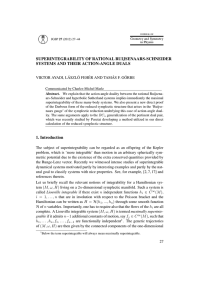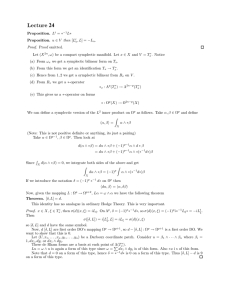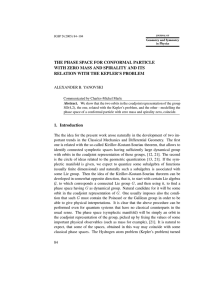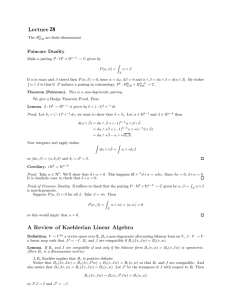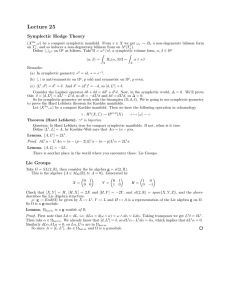SYMPLECTIC GEOMETRY, LECTURE 2
advertisement
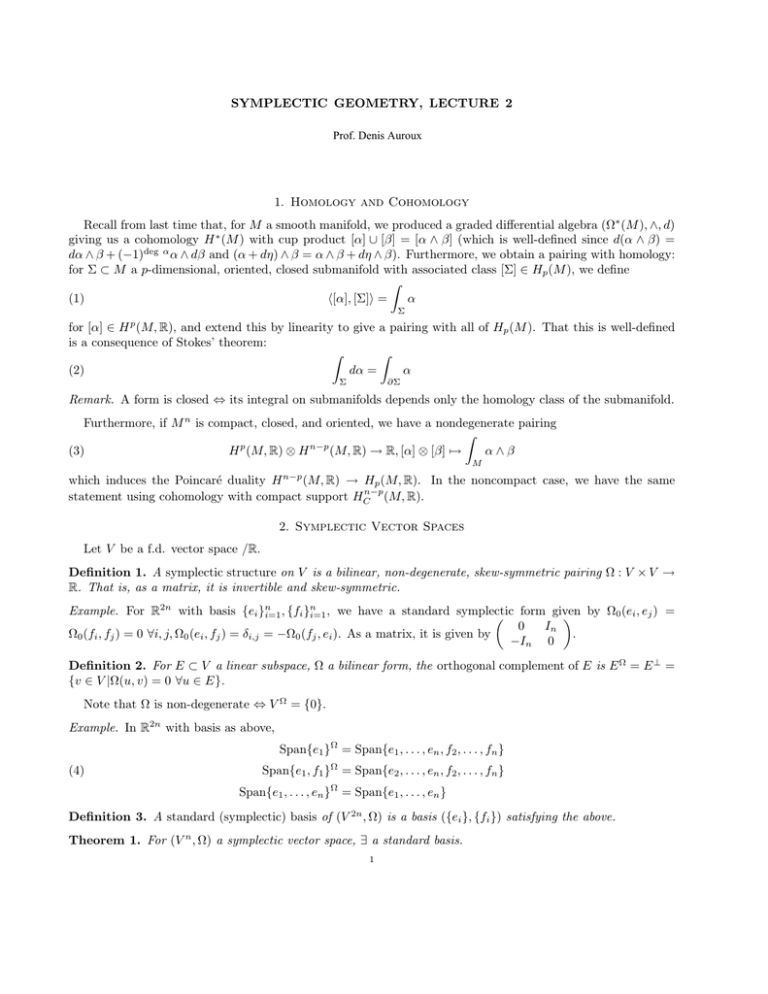
SYMPLECTIC GEOMETRY, LECTURE 2
Prof. Denis Auroux
1. Homology and Cohomology
Recall from last time that, for M a smooth manifold, we produced a graded differential algebra (Ω∗ (M ), ∧, d)
giving us a cohomology H ∗ (M ) with cup product [α] ∪ [β] = [α ∧ β] (which is well-defined since d(α ∧ β) =
dα ∧ β + (−1)deg α α ∧ dβ and (α + dη) ∧ β = α ∧ β + dη ∧ β). Furthermore, we obtain a pairing with homology:
for Σ ⊂ M a p-dimensional, oriented, closed submanifold with associated class [Σ] ∈ Hp (M ), we define
�
�[α], [Σ]� =
α
(1)
Σ
p
for [α] ∈ H (M, R), and extend this by linearity to give a pairing with all of Hp (M ). That this is well-defined
is a consequence of Stokes’ theorem:
�
�
dα =
α
(2)
Σ
∂Σ
Remark. A form is closed ⇔ its integral on submanifolds depends only the homology class of the submanifold.
Furthermore, if M n is compact, closed, and oriented, we have a nondegenerate pairing
�
H p (M, R) ⊗ H n−p (M, R) → R, [α] ⊗ [β] �→
α∧β
(3)
M
n−p
which induces the Poincaré duality H
(M, R) → Hp (M, R). In the noncompact case, we have the same
statement using cohomology with compact support HCn−p (M, R).
2. Symplectic Vector Spaces
Let V be a f.d. vector space /R.
Definition 1. A symplectic structure on V is a bilinear, non-degenerate, skew-symmetric pairing Ω : V × V →
R. That is, as a matrix, it is invertible and skew-symmetric.
Example. For R2n with basis {ei }ni=1 , {fi }ni=1 , we have a standard symplectic
� form given
� by Ω0 (ei , ej ) =
0
In
Ω0 (fi , fj ) = 0 ∀i, j, Ω0 (ei , fj ) = δi,j = −Ω0 (fj , ei ). As a matrix, it is given by
.
−In 0
Definition 2. For E ⊂ V a linear subspace, Ω a bilinear form, the orthogonal complement of E is E Ω = E ⊥ =
{v ∈ V |Ω(u, v) = 0 ∀u ∈ E}.
Note that Ω is non-degenerate ⇔ V Ω = {0}.
Example. In R2n with basis as above,
Span{e1 }Ω = Span{e1 , . . . , en , f2 , . . . , fn }
(4)
Span{e1 , f1 }Ω = Span{e2 , . . . , en , f2 , . . . , fn }
Span{e1 , . . . , en }Ω = Span{e1 , . . . , en }
Definition 3. A standard (symplectic) basis of (V 2n , Ω) is a basis ({ei }, {fi }) satisfying the above.
Theorem 1. For (V n , Ω) a symplectic vector space, ∃ a standard basis.
1
Prof. Denis Auroux
2
Proof. We induce on n: the base case is trivial. Choose some vector e1 ∈ V � {0}. By nondegeneracy,
Ω(ei , ·) �= 0 =⇒ ∃f1 s.t. Ω(e1 , f1 ) = 1. Let W = Span{e1 , f1 }Ω : then Ω|W is symplectic since u ∈ W, Ω(u, q) =
0 ∀w ∈ W =⇒ Ω(u, e1 ) = 0, Ω(u, f1 ) = 0 =⇒ u = 0. Furthermore, V = Span{e1 , f1 } ⊕ W . To see this, note
first that, if v = ae1 + bf1 ∈ W, Ω(e1 , v) = b = 0 and Ω(f1 , v) = a = 0, so W ∩ Span{e1 , f1 } = ∅. Secondly, for
v ∈ V , we can write v = w + ae1 + bf1 , where w = v − Ω(e1 , v)f1 + Ω(f1 , v)e1 ∈ W . Since W has dimension
�
n − 2, we are done.
Corollary 1. V symplectic =⇒ V is even-dimensional and symplectomorphic to (R2n , Ω0 ).
We denote the symplectic automorphisms of (V, Ω) by Sp(V, Ω) = Sp(2n, R).
∼
=
Remark. dim E Ω = dim V − dim E because V → V ∗ → E ∗ , v �→ Ω(v, ·) �→ Ω(v, ·)|E is surjective with kernel
EΩ.
Definition 4. E ⊂ V is a symplectic subspace if Ω|E is nondegenerate, e.g. in a standard basis E is the span
of
(e1 , f1 , . . . , ek , fk )
(5)
Problem. Prove that E is a symplectic subspace ⇔ E ∩ E Ω = {0} ⇔ V = E ⊕ E Ω .
Definition 5. E ⊂ V is an isotopic (resp. coisotopic, lagrangian) subspace if E ⊂ E Ω (resp. E Ω ⊂ E, E Ω = E),
e.g. in a standard basis E is the span of (e1 , . . . , ek ) (resp. (e1 , f1 , . . . , ek , fk , ek+1 , . . . en ), (e1 , . . . , en )).
Example. For E ⊂ V Lagrangian with basis (e1 , . . . , en ), we can complete this to a symplectic basis
(6)
(e1 , . . . , en , f1 , . . . , fn )
of V .
�2 ∗
(where Ω is considered as an element of
(V ).
� i
Note that, since Ω is nondegenerate, we can write Ω = i e ∧ f i , so Ω∧n = n!e1 ∧ f 1 ∧ · · · ∧ en ∧ f n is a
non-zero top form, and our volume form is well-defined. In fact, Ω∧n �= 0 ⇔ Ω is nondegenerate.
Definition 6. The symplectic volume form is
1 ∧n
n! Ω
3. Symplectic Manifolds
Let M be a smooth manifold.
Definition 7. A symplectic form on M is a 2-form ω (i.e. a skew-symmetric pairing ωp : Tp M × Tp M → R
1 n
ω is a volume form) and closed (i.e. dω = 0).
for all p ∈ M ) which is nondegenerate (i.e. n!
2
Remark. M symplectic =⇒ it is even-dimensional and naturally
� ωn oriented. Moreover, [ω] ∈ H (M, R) plays an
� 0.
important role, especially if M is compact, as in this case M n! = vol(M ) > 0 =⇒ [ω] =
�
2n
n
Example.
For R , ω0 =
dxi ∧ dyi is the standard symplectic structure: for C , we write this as ω =
�
i
dz
∧
dz
instead.
Furthermore,
for an orientable surface Σ, any area form is a symplectic form.
j
j
2
Problem. For which values of n does S 2n (resp. T 2n ) have a symplectic structure?
Definition 8. A symplectomorphism is a diffeomorphism φ : (M, ω) → (M � , ω � ) s.t. φ∗ ω � = ω.
We denote the group of symplectomorphisms of M by Symp(M, ω).
Example. For S 2 ⊂ R3 , Symp(S 2 ) is the group of area and orientation preserving diffeomorphisms, which is
much larger than the group of isometries.
Theorem 2 (Darboux). �
Every symplectic manifold is locally symplectomorphic to (R2n , ω), i.e. it has local
coordinates in which ω =
dxi ∧ dyi .

